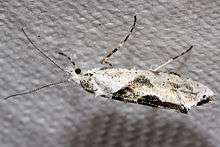Ypsolopha
Ypsolopha is a genus of moths of the family Ypsolophidae. It is the type genus of the family and comprises over 120 described species (about 95% of the family's known world diversity).
| Ypsolopha | |
|---|---|
 | |
| Ypsolopha asperella | |
| Scientific classification | |
| Kingdom: | |
| Phylum: | |
| Class: | |
| Order: | |
| Family: | |
| Subfamily: | Ypsolophinae |
| Genus: | Ypsolopha |
| Synonyms | |
| |
Distribution
Most Ypsolopha species have been recorded from the Holarctic temperate region.
Description
Ypsolopha species are variable in shape and color and no exclusive superficial features have been established for the group. In contrast, the genitalia of both sexes are remarkably homogeneous.
Biology
Adults are nocturnal or rarely diurnal. Their resting postures are various, but they often have the head down and the lower body up. Ypsolopha acuminata mimics a small broken branch at rest. The larvae usually live in open webs on the leaves of various, primarily woody, plants and mostly feed on a limited range of host plants. They are active primarily at night and have two defensive behaviors that involve wiggling and jumping.
Selected species
- Ypsolopha acerella Ponomarenko, Sohn & Zinchenko, 2011[2]
- Ypsolopha acuminata (Butler, 1878)
- Ypsolopha albiramella (Mann, 1861)
- Ypsolopha albistriatus (Issiki, 1930)
- Ypsolopha aleutianella (Beutenmüller, 1889)
- Ypsolopha alpella (Denis & Schiffermüller, 1775)
- Ypsolopha amoenella (Christoph, 1882)
- Ypsolopha angelicella (Busck, 1903)
- Ypsolopha arizonella (Busck, 1903)
- Ypsolopha asperella (Linnaeus, 1761)
- Ypsolopha atrobrunnella Ponomarenko & Sohn, 2011[2]
- Ypsolopha aurata Moriuti, 1977
- Ypsolopha barberella (Busck, 1903)
- Ypsolopha blandella (Christoph, 1882)
- Ypsolopha buscki Heppner, 1982
- Ypsolopha cajaliella Vives, 2003
- Ypsolopha canariella (Walsingham, 1881)
- Ypsolopha cervella (Walsingham, 1881)
- Ypsolopha chazariella (Mann, 1866)
- Ypsolopha cockerella (Busck, 1903)
- Ypsolopha colleaguella Baraniak, 2007
- Ypsolopha contractella (Caradja, 1920)
- Ypsolopha coriacella (Herrich-Schäffer, 1855)
- Ypsolopha costibasella (Caradja, 1939)
- Ypsolopha cristata Moriuti, 1977
- Ypsolopha delicatella (Busck, 1903)
- Ypsolopha dentella (Fabricius, 1775)
- Ypsolopha dentiferella (Walsingham, 1881)
- Ypsolopha diana (Caradja, 1939)
- Ypsolopha distinctatus Moriuti, 1977
- Ypsolopha divisella (Chrétien, 1915)
- Ypsolopha dorsimaculella (Kearfott, 1907)
- Ypsolopha electropa (Meyrick, 1914)
- Ypsolopha elongata (Braun, 1925)
- Ypsolopha ephedrella (Christoph, 1873)
- Ypsolopha excisella (Lederer, 1855)
- Ypsolopha exsularis (Meyrick, 1937)
- Ypsolopha falcella (Denis & Schiffermüller, 1775)
- Ypsolopha falciferella (Walsingham, 1881)
- Ypsolopha flavistrigella (Busck, 1906)
- Ypsolopha flava (Issiki, 1930)
- Ypsolopha fractella (Chrétien, 1915)
- Ypsolopha frustella (Walsingham, 1881)
- Ypsolopha fujimotoi Moriuti, 1964
- Ypsolopha gerdanella (Busck, 1903)
- Ypsolopha helva J.C. Sohn & C.S. Wu, in Sohn et al., 2010
- Ypsolopha heteraula (Meyrick, 1927)
- Ypsolopha horridella (Tritschke, 1835)
- Ypsolopha indecorella (Rebel, 1903)
- Ypsolopha instabilella (Mann, 1866)
- Ypsolopha japonica Moriuti, 1964
- Ypsolopha kristalleniae Rebel, 1916
- Ypsolopha leptaula (Meyrick, 1927)
- Ypsolopha leuconotella (Snellen, 1884)
- Ypsolopha lonicerella Stökl, 1922
- Ypsolopha longa Moriuti, 1964
- Ypsolopha lucella (Fabricius, 1775)
- Ypsolopha lutisplendida Sohn & Wu, 2011[2]
- Ypsolopha lyonothamnae (Powell, 1967)
- Ypsolopha maculatella (Busck, 1906)
- Ypsolopha manella (Busck, 1903)
- Ypsolopha manniella (Staudinger, 1880)
- Ypsolopha melanocnista (Meyrick, 1938)
- Ypsolopha melanofuscella Ponomarenko & Zinchenko, 2013
- Ypsolopha mienshani (Caradja, 1939)
- Ypsolopha minotaurella (Rebel, 1916)
- Ypsolopha mucronella (Scopoli, 1763)
- Ypsolopha nebulella (Staudinger, 1871)
- Ypsolopha nella (Busck, 1903)
- Ypsolopha nemorella (Linnaeus, 1758)
- Ypsolopha nigrimaculata Byun et Park, 2001
- Ypsolopha nigrofasciata Yang, 1977
- Ypsolopha oliviella (Busck, 1903)
- Ypsolopha parallela (Caradja, 1939)
- Ypsolopha parenthesella (Linnaeus, 1761)
- Ypsolopha parodaula (Meyrick, 1938)
- Ypsolopha persicella (Fabricius, 1787)
- Ypsolopha pseudoparallela J.C. Sohn & C.S. Wu, in Sohn et al., 2010
- Ypsolopha querciella (Busck, 1903)
- Ypsolopha rubrella (Dyar, 1902)
- Ypsolopha rhytidota (Meyrick, 1938)
- Ypsolopha saitoi Moriuti, 1964
- Ypsolopha sarmaticella (Rebel, 1917)
- Ypsolopha sasayamanus (Matsumura, 1931)
- Ypsolopha satellitella (Staudinger, 1871)
- Ypsolopha scabrella (Linnaeus, 1761)
- Ypsolopha schwarziella (Busck, 1903)
- Ypsolopha sculpturella (Herrich-Schäffer, 1854)
- Ypsolopha semitessella (Mann, 1861)
- Ypsolopha senex (Walsingham, 1889)
- Ypsolopha seniculella (Christoph, 1872)
- Ypsolopha sequella (Clerck, 1759)
- Ypsolopha sordida J.C. Sohn & C.S. Wu, in Sohn et al., 2010
- Ypsolopha straminella Ponomarenko & Zinchenko, 2013
- Ypsolopha striatella (Busck, 1903)
- Ypsolopha strigosus (Butler, 1879)
- Ypsolopha sublucella (Walsingham, 1881)
- Ypsolopha sylvella (Linnaeus, 1767)
- Ypsolopha tesselatidorsata Ponomarenko & Zinchenko, 2011[2]
- Ypsolopha trichonella (Mann, 1861)
- Ypsolopha tsugae Moriuti, 1977
- Ypsolopha undulatella (Busck, 1906)
- Ypsolopha unicipunctella (Busck, 1903)
- Ypsolopha uniformis (Filipjev, 1929)
- Ypsolopha ustella (Clerck, 1759)
- Ypsolopha vintrella (Busck, 1906)
- Ypsolopha vittella (Linnaeus, 1758)
- Ypsolopha walsinghamiella (Busck, 1903)
- Ypsolopha yangi Ponomerenko & Sohn, 2011[2]
- Ypsolopha yasudai Moriuti, 1964
Former species
- Ypsolopha scenites (Meyrick, 1909)
References
- Descriptions of three new species of Ypsolopha Latreille (Lepidoptera: Ypsolophidae) from East Asia, redescription of Y. contractella (Caradja) and a checklist of East Asian Ypsolopha
- Ponomarenko, M.G., Sohn, J.-C., Zinchenko, Y.N., & Wu, C.-S. "Five new East-Asian species of the genus Ypsolopha Latreille (Lepidoptera: Ypsolophidae)." Zootaxa 2760 (2011): 18-28.
External links
![]()